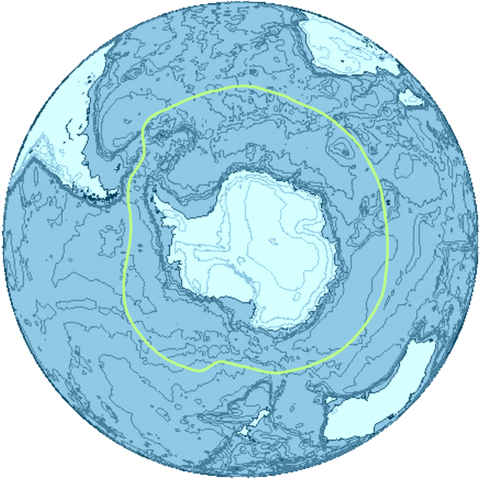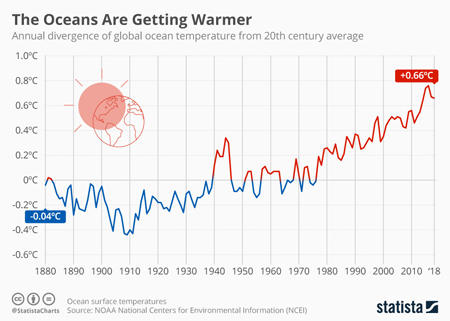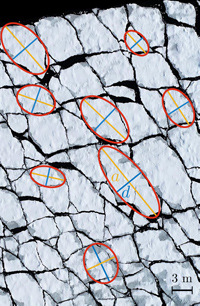
"Oceans are our friends. They suck in carbon, they give out oxygen, they help our planet to breathe," says mathematician Luke Bennetts. "They also soak up 90% of excess heat we create through burning fossil fuels."
Perhaps the best example is the Southern Ocean. "The Southern Ocean is an interrupted oceanic ring that sits beneath all of the continents inhabited by humans," says Bennetts. "It connects almost all of the major oceans to the North, and it's the gateway to the Antarctic to the South."

The Southern Ocean. Image: Apcgb, CC BY-SA 3.0.
Bennetts lives in Adelaide, Australia, so the Southern Ocean is on his doorstep. But its influence, he says, spreads far beyond, affecting the entire planet. "The Southern Ocean is like no other ocean. It works harder than any other ocean to counteract climate change."
Hard-working and extreme
The Southern Ocean certainly isn't a stranger to extremes. Some of the strongest winds on Earth blow across its surface, uninterrupted by land, whipping up the largest waves on the planet, up to 20 metres high, the size of a five storey building. Those winds also drive continual movement of water, both in the horizontal and vertical directions. "The movement brings up cold water from deep down to the ocean surface, which is then moved North where it is heated, and then [sinks] back down deep [in the ocean] again," explains Bennetts.
"Another reason the Southern Ocean is special is because it's where the cold waters from the South meet the warm waters from the North. They meet in the strongest, fastest current on our planet, known as the Antarctic Circumpolar Current, or ACC. The ACC pumps water around the Southern Ocean rapidly, and, in doing so, redistributes heat, fresh water, and carbon dioxide to all the other major oceans to the North."
The Antarctic Circumpolar Current. Animation courtesy NASA, public domain
The ACC also acts as a barrier that protects the Antarctic ice sheet from warm waters. "[The Antarctic ice sheet] is by far the greatest store of freshwater on the planet," says Bennetts. It has the potential to cause a dramatic increase in sea levels around the world.
The frozen surface layer of seawater that surrounds Antarctica, known as sea ice, is another crucial component in the Earth's climate. "It reflects the Sun's rays to keep the Southern Ocean cool. It's a really important component of the Southern Ocean system. It expands and contracts with the seasons, and in winter it doubles the size of the Southern ice cap." Indeed, the existence of sea ice plays an important role in keeping down the temperature of the entire planet — for an interesting illustration of this, see the article Climate modelling made easy.
A changing environment
As you might expect, however, the Southern Ocean is changing. "It's warming, and that is having knock-on effects such as record Antarctic sea ice lows, and losses of major ice shelves. It's not clear how long the Southern Ocean can go on playing its critical role in the climate system."

The broad mechanism behind what will happen if we don't change our ways is straightforward. "If we keep on pumping carbon into the atmosphere, the oceans will keep on warming, sea ice will retreat, ice shelves will collapse, and the Antarctic ice sheet will melt into the Southern Ocean."
What we don't know is exactly how and when this will play out, and whether it might be reversible. "This is fiendishly difficult. It requires that we understand the feedbacks between the different components of the Southern Ocean," says Bennetts.
Underwater waterfalls
Bennetts is one of a large number of scientists who are working on understanding the complex Southern Ocean system. But he is not an oceanographer, or a climate scientist — he is a mathematician. He talked about the Southern Ocean at a recent conference organised by the Society for Industrial and Applied Mathematics, and he is currently co-organising a research programme at the Isaac Newton Institute for Mathematical Sciences in Cambridge, which is where we met him. (You can find out more about this research programme here.)
The reason Bennetts can contribute to Southern Ocean sciences is that maths underpins the main tools we have for understanding the world and making predictions about what may happen. For a dramatic example of this, watch the animation below:
The visualisation was produced by a team of scientists led by Andy Hogg from the ANU hub of ARC Centre of Excellence for Climate System Science, working with the National Computational Infrastructure's VizLab team, using a high-resolution ocean model. Find out more here.
"The animation starts at the [surface of the Southern Ocean] showing properties like the sea surface temperature and sea ice coverage," explains Bennetts. "But the real power is that it allows us to strip away the surface layer and look deep into the Southern Ocean. There we find waterfalls of cold, dense water plummeting kilometres over the edge of the Antarctic continental shelf. We also find underwater waves hundreds of metres high." This kind of information is important in understanding large-scale Southern Ocean circulation, which depends, not only on what happens on the surface of the ocean, but also on its motion deep down in the abyss.
The computer program which generates this spectacular insight and can predict future scenarios comes from what is called a numerical model. This is based on theories from physics that describe the processes involved and are phrased in the language of maths. An example comes from the Navier-Stokes equations, which describe the behaviour of fluids such as ocean water. However, building a complete theoretical picture of the ocean's behaviour is no easy feat. "Developing mathematical theories of such a complex system as a three-dimensional ocean is intimidating," says Bennetts.
To get around the difficulties, scientists simplify the picture, for example by assuming that the ocean is a stack of water layers where each individual layer has uniform properties, for example uniform density. Numerical models are calibrated and validated against real-life observations. Gathering those means taking measurements deep down, kilometres below the ocean surface. Compounding the difficulties further on the theoretical side is that the equations involved are incredibly difficult to solve, so you need sophisticated methods for finding accurate approximate solutions.
A numerical model is the culmination of all these efforts. Using a large amount of computing power (the animation above was produced on a supercomputer) it approximates solutions and produces predictions of the ocean dynamics. If the model's outputs match what we observe in reality, then that's good evidence that its predictions are reasonably accurate. We can then also have confidence in what the model tells us about the depths of the ocean we can't easily observe. By tweaking the parameters and/or components of the model, scientists can also explore what might happen when conditions change, for example through global warming.
Breaking the ice
What we've seen above are the three main tools scientists have at their disposal to understand the ocean and what might happen with it in the future: theory, observations and numerical models. All three tools are underpinned by maths. Physical theories are written in the language of mathematics, observations are analysed and turned into usable data using mathematics, and numerical models are essentially computer codes for solving equations.
Scientists use these tools, not only to get a sense of the behaviour of the entire ocean, but also to better understand and predict individual processes that feed into the big picture. The movie below shows an example of such a process: ocean waves breaking up sea ice cover into chunks called ice floes. These melt more rapidly than continuous sea ice covers, so understanding how they form and what they tend to look like is important in understanding how sea ice melts.
This movie is from Aerial footage of wave-induced sea ice breakup in the Gulf of Saint-Lawrence by Elie Dumas-Lefebvre and Dany Dumont, published in The Cryosphere in 2023. Reproduced under CC BY-NC-ND 4.0.
The movie was filmed in a “natural laboratory” in an estuary in Quebec, Canada, rather than the Southern Ocean. But it illustrates the physical processes at play. "It's a really exciting example of the observations we might get in the Southern Ocean in the future as drones and other technologies mature."
From these kinds of observations scientists can extract features such as ice floe sizes, and they can analyse their statistical properties. Bennetts and other mathematicians are also developing associated theories, coupling together the physical theories that describe water waves on the one hand and sea ice on the other. They also use the theory of multiple wave scattering that is the topic of the six-month-long research programme at the Isaac Newton Institute which Bennetts is co-organising. The mathematical theories form the basis of numerical models that can be verified by observations and help us understand how sea ice breaks up into floes.

A mathematical analysis of the shape of observed ice floes. Image from Aerial footage of wave-induced sea ice breakup in the Gulf of Saint-Lawrence by Elie Dumas-Lefebvre and Dany Dumont, published in The Cryosphere in 2023. Reproduced under CC BY-NC-ND 4.0.
Under the ice
For a final example of extreme observation gathering, watch the movie below. It was filmed below the Thwaites glacier, which is nicknamed the doomsday glacier as it is considered the greatest threat to global sea levels over the next decade. "That's because the base of the ice shelf it's attached to is thinning rapidly," says Bennetts.
To find out more about what is happening at the base, scientists drilled through over 500m of ice and deployed underwater robots. "At the ice shelf base they found features, called terraces, which give clues about the melting processes that go on there."
Video from Heterogeneous melting near the Thwaites Glacier grounding line by B.E.Schmidt et al., published in Nature in 2023. Reproduced under CC BY 4.0
Observations from below the ice again need to be complemented by specialised theories. "Basal ice melt rates can't be predicted simply from knowing the ocean temperature. We need to know about how both heat and salt are moved between the ice and the water. The controlling processes are too small and fast to be captured by numerical models [designed to describe an entire ice shelf.]" What is needed are theories that describe, for example, staircase structures of water layers that control melt rates. "We can then feed these theories into numerical models and make predictions," says Bennetts.
The three examples we've visited in this article illustrate just some of the components of Southern Ocean science. More research — on observations, theories, and numerical models — is needed to extend and refine the understanding we need to predict how the Southern Ocean is likely to change in the future, what this means for our planet, and if there is anything we can do to reverse the change. Mathematics lies at the heart of this work.
About this article
This article is based on Luke Bennett's talk at the SIAM Conference on Computational Science and Engineering, which took place in March 2023.
Luke Bennetts is an Australian Research Council Future Fellow and an Associate Professor in the School of Mathematical Sciences, University of Adelaide. He is one of the organisers of a research programme on the mathematical theory and applications of multiple wave scattering that is currently taking place at the Isaac Newton Institute for Mathematical Sciences in Cambridge. You can find out more about this research programme here.
Marianne Freiberger is Editor of Plus.
This article was produced as part of our collaboration with the Isaac Newton Institute for Mathematical Sciences (INI) – you can find all the content from the collaboration here.
The INI is an international research centre and our neighbour here on the University of Cambridge's maths campus. It attracts leading mathematical scientists from all over the world, and is open to all. Visit www.newton.ac.uk to find out more.
